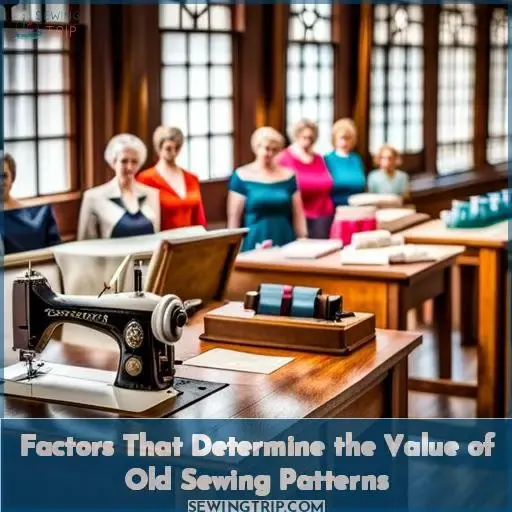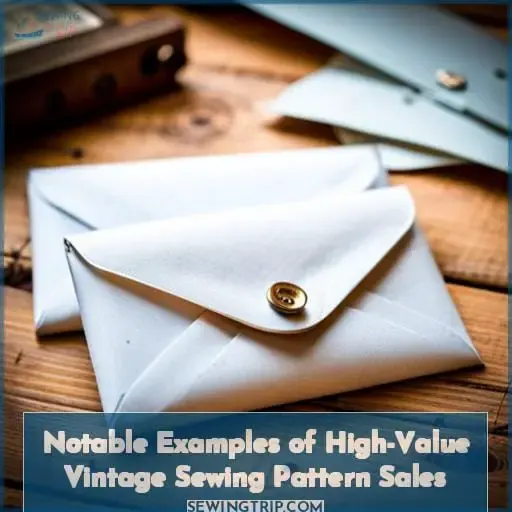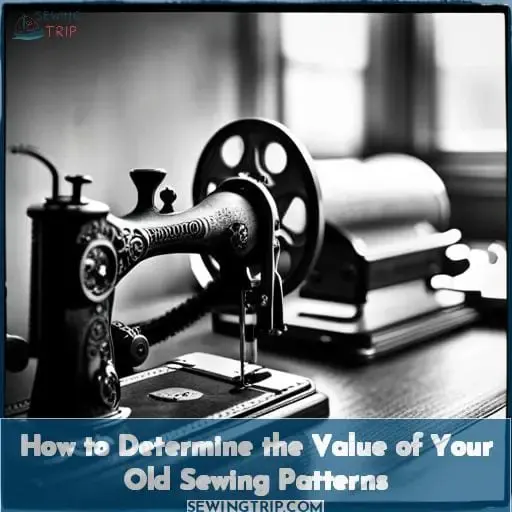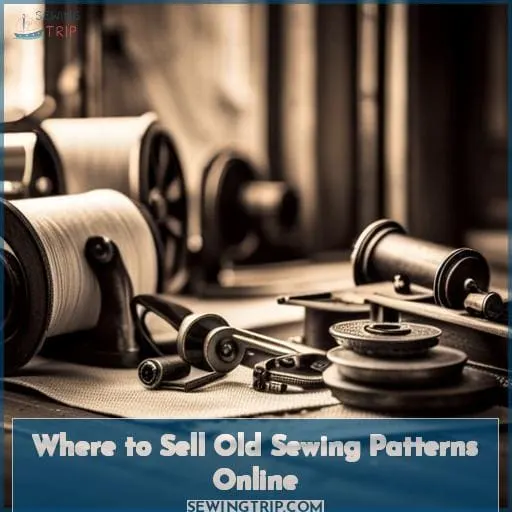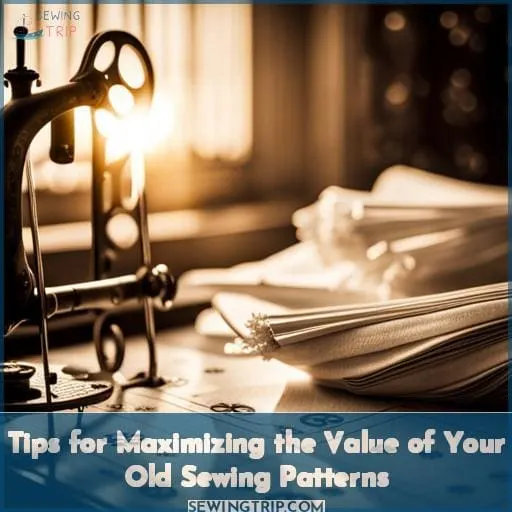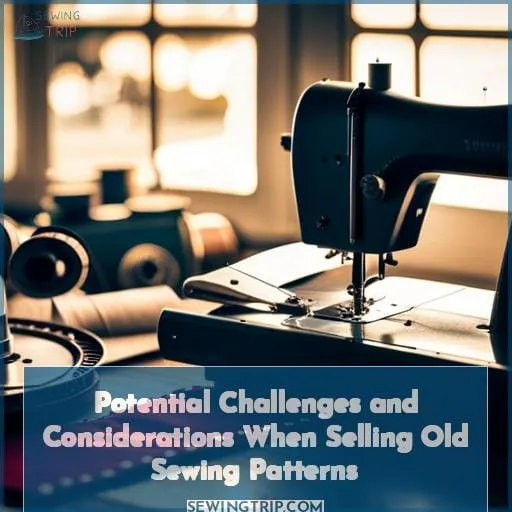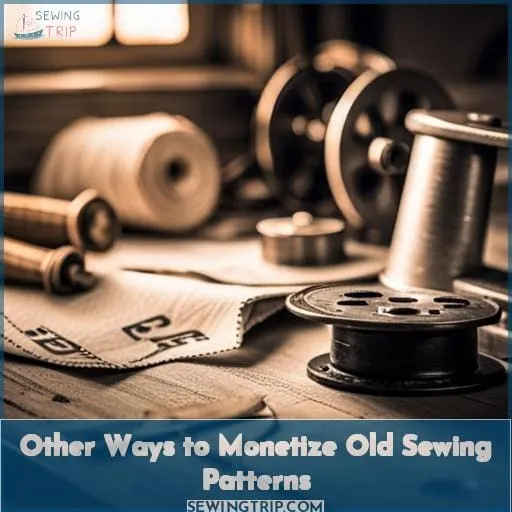This site is supported by our readers. We may earn a commission, at no cost to you, if you purchase through links.
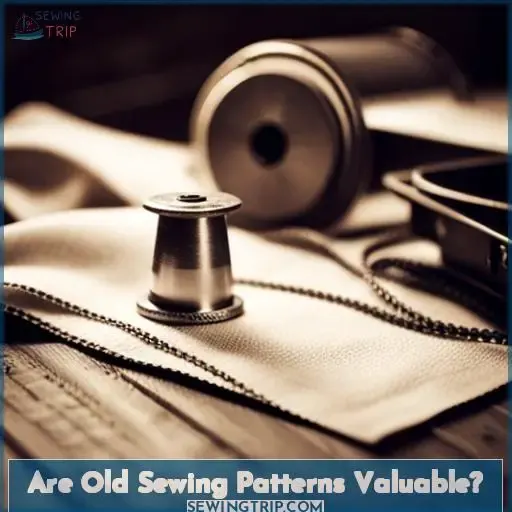 If you’ve got an old sewing pattern tucked away, it could be worth a pretty penny! Like many collectibles, the value of vintage patterns depends on rarity and scarcity.
If you’ve got an old sewing pattern tucked away, it could be worth a pretty penny! Like many collectibles, the value of vintage patterns depends on rarity and scarcity.
But how can you tell if your find is worth anything? We’re taking a deep dive to uncover what makes certain sewing patterns valuable and where to sell them online for maximum profit.
From limited edition designs to rare designer pieces – there’s no end of potential in the world of old sewing patterns! So grab that dusty box off the shelf and let’s get started on discovering whether those needles have any hidden gold threading through them.
Table Of Contents
- Key Takeaways
- Factors That Determine the Value of Old Sewing Patterns
- Notable Examples of High-Value Vintage Sewing Pattern Sales
- How to Determine the Value of Your Old Sewing Patterns
- Where to Sell Old Sewing Patterns Online
- Tips for Maximizing the Value of Your Old Sewing Patterns
- Potential Challenges and Considerations When Selling Old Sewing Patterns
- Other Ways to Monetize Old Sewing Patterns
- Conclusion
Key Takeaways
- The rarity, designer labels, condition, and age are key factors in determining the value of vintage sewing patterns.
- Researching completed sales listings, consulting sewing pattern price guides, and obtaining expert appraisals can help determine the value of old sewing patterns.
- Online platforms such as eBay and sewing/craft forums or groups provide venues for selling vintage sewing patterns.
- Proper storage, clear photographs, attractive listings, and value-added options like bundles or sets may increase the worth of aged sewing patterns.
Factors That Determine the Value of Old Sewing Patterns
Collectors know that demand and supply drive vintage pattern prices up. Hard-to-find designer patterns from any era command premium prices if they are rare and in great condition.
Rarity and Scarcity
You’ll pay top dollar for those hard-to-find patterns from the 1940s! Rarity significantly impacts pricing for vintage sewing collectors. They recognize historical significance and market scarcity, seeking the uncommon and unique.
Patterns with low circulation numbers or iconic stylistic elements bring higher market value. Rarity denotes historical intrigue. Collectors pursue elusive designs that provide coveted glimpses into fashion’s past.
Designer or Brand
You ought to keep in mind sewing patterns branded by vintage fashion designers fetch higher prices nowadays. Vintage patterns by key designers are sought after, including Vogue’s stylish fashions made for the everyday home sewer.
Brand plays a role in determining value; rare designer finds like vintage Vogue can be quite valuable. Remember limited edition and scarce designer patterns often appraise higher based on vintage pattern knowledge.
Condition and Completeness
Folks, you have to inspect that vintage pattern carefully for missing pieces before forking over your hard-earned cash.
- Check for a full instructions sheet.
- Ensure all pattern pieces are present.
- Examine the envelope condition and markings.
- Look for any tears, stains, or damage.
When assessing old sewing patterns, condition and completeness dramatically impact value. Pristine, flawless patterns fetch top dollar. Damaged or incomplete versions plummet in price.
Age and Era
Folks will find the age and era of vintage patterns determine worth, as older patterns from earlier decades tend to garner more interest. Patterns from the 1950s and 1960s are very popular right now as mid-century modern design enjoys a revival.
Pricing trends show sewing patterns gaining value as they age, with the most coveted decades being the post-war 1940s and 1950s. Specific eras see more demand from collectors based on nostalgia and cultural significance.
Generally, the evolution of design means earlier decades represent more unique styles that set vintage patterns apart.
Demand and Popularity
The value of a sewing pattern increases when it reflects a style that’s currently in demand. For example, patterns that fulfill niche interests like vintage swimwear or designer reproductions may have high appeal among collectors.
When a vintage style becomes fashionable again, common patterns from that era gain value due to renewed popularity. Rarity also fuels demand; unusual vintage patterns command high prices. Overall, analyzing fashion trends and collector’s markets is key to understanding what vintage sewing patterns are worth.
Notable Examples of High-Value Vintage Sewing Pattern Sales
Valuable vintage sewing patterns can fetch high prices at auction. For example, rare vintage Vogue designs, limited edition Simplicity collections, and patterns by famous designers like McQueen or Chanel may sell for over $100 or more.
Vintage Vogue Patterns
You’d cherish discovering the coveted vintage Vogue creations with eternal style at flea markets for less than a dollar. The uncommon, genuine Couturier Designs and Paris Originals order peak costs among collectors.
What’s presently vintage addressed at the tallness of design previously. The exquisite styles and thorough subtleties set Vogue designs apart. Rarity and interest drive costs for the most looked for after vintage Vogue designs upwards.
Rare Designer Patterns
You don’t often see rare couture patterns by iconic designers like Chanel or Dior come up for sale.
- Original Dior New Look patterns from the 1950s.
- Vintage Jacques Fath gown designs.
- Authentic 1920s Madeleine Vionnet patterns.
Vintage couture sewing patterns by iconic designers are the holy grail for collectors. Finding them takes patience and persistence, but the rewards can be incredible. With couture-level construction details, these rare patterns provide a glimpse into hidden fashion history.
Limited Edition or Special Collection Patterns
Have you ever wondered if that rare, limited edition Simplicity pattern from the 1950s stashed in grandma’s attic could be worth a pretty penny? Limited edition and special collection sewing patterns often fetch top dollar due to their rarity.
Vintage pattern collectors seek out these unique, hard-to-find gems. Limited run prints like Hollywood patterns or designer collaborations can cause pattern value to skyrocket. Rarity does not always mean valuable, but limited edition and special collection vintage sewing patterns offer coveted uniqueness that increases prices.
How to Determine the Value of Your Old Sewing Patterns
When determining the value of your old sewing patterns, start by researching similar listings. Look at sold listings on sites like eBay and Etsy to get an idea of what patterns in comparable condition from the same era, designer, and style have recently sold for.
This market research will provide a good benchmark for pricing your vintage patterns.
To determine the value, research sold listings for comparable patterns from the same time period, designer, and style.
Use sites like eBay and Etsy to view sold listings of similar vintage sewing patterns. Analyzing comparable sold patterns in equivalent condition provides valuable pricing context.
Researching Similar Listings
Comparing similar completed listings helps accurately value your patterns. Referencing historical sales data and current market trends when pricing your vintage sewing patterns helps determine fair pricing.
Studying listing descriptions of comparable patterns that recently sold and employing comparative pricing strategies using this historical data helps determine fair market value. Setting prices in line with similar sold listings attracts buyers who recognize a good deal.
Vintage sewing patterns have enthusiastic collectors seeking quality items, so researching ensures you price to sell.
Consulting Price Guides and Reference Books
Checking price guides and reference books provides specifics on pattern designers, publication dates, and pricing comparisons for determining the value of your vintage sewing patterns. Collectors’ catalogs, price guides, or appraisal services offer resources for identifying patterns by signature, dating, publication runs, scarcity, and other market trends.
Consulting well-researched collectors’ resources gives insight into the full potential value of old sewing patterns.
Seeking Appraisal From Experts or Collectors
You’re advised to seek out appraisal from vintage sewing pattern experts or avid collectors for a dependable estimate of your patterns’ worth. Understanding their criteria and insights can help pinpoint the most valuable pieces in your collection.
Experts examine design details, condition, rarity, and provenance when assessing vintage patterns. An expert’s experienced eye spots collectible gems. While sales-motivated appraisals should be vetted, specialists offer invaluable perspective, helping you make informed decisions when selling beloved patterns.
Where to Sell Old Sewing Patterns Online
When you’re ready to sell your old sewing patterns online, turn to vintage and collectible websites along with sewing and craft forums and groups. These online markets offer easy selling, shipping, and exposure to buyers seeking retro and vintage styles.
Vintage and Collectible Websites
Turning to the marketplaces trusted by serious collectors exposes your vintage sewing patterns to enthusiasts willing to pay premium prices. eBay remains the go-to auction website, with over 182 million active buyers globally bidding on rare finds.
Fellow aficionados on specialized forums appraise and value designer patterns from coveted eras. Online appraisals indicate potential earnings before listing vintage sewing patterns worth top dollar on trusted vintage marketplaces.
Sewing and Craft Forums and Groups
Joining sewing and craft forums lets you tap into a passionate community eager to find that special vintage pattern. You’ll get tips from seasoned collectors on identifying rarities, valuation, and online marketplaces to sell your vintage patterns.
Fellow enthusiasts share insights on designers, history, and community events. With this knowledge, you will confidently resell patterns legally online.
Tips for Maximizing the Value of Your Old Sewing Patterns
Are your vintage sewing patterns worth anything? Here are some tips for maximizing their value. Properly storing and preserving patterns in archival-quality materials will maintain their condition, increasing their appeal to collectors and helping them retain their worth.
Use acid-free tissue, envelopes, and boxes when possible to provide protection from light, moisture, insects, and other elements that can lead to deterioration over time. Consider wrapping each pattern in archival tissue paper before placing inside a protective envelope.
Store patterns flat and evenly spaced inside acid-free boxes to prevent creasing and damage. Maintain a cool, dark, dry environment inside closets or cupboards. Limit exposure to light, which can cause fading.
Careful handling and storage provides the best protection for delicate vintage sewing patterns, preserving their condition and collectible value over the years.
Properly Storing and Preserving Patterns
Keep tissue patterns flat and stored properly to prevent tearing and deterioration over time.
Avoid folding or rolling patterns to prevent weakening the tissue. Store patterns in archival plastic sleeves or between acid-free paper. Use pattern weights or books to keep patterns from curling. Consistent climate control helps maintain pattern quality.
Proper care preserves vintage patterns for years of creative projects.
Keep tissue patterns flat and stored properly to prevent tearing and deterioration over time.
| Storage Solutions | Benefits | Things to Avoid |
|---|---|---|
| Archival plastic sleeves | Protects from dust, bugs, light damage | Folding, rolling patterns |
| Acid-free paper | Buffers against humidity changes | Direct sunlight, heat exposure |
| Pattern weights | Prevents curling | Fluctuating temperature/humidity |
| Mothballs | Deters bugs from eating paper | Damp environments |
| Consistent climate control | Maintains pattern integrity | Pattern stacking/crowding |
Proper care preserves vintage patterns for creative projects for years.
Providing Detailed and Accurate Descriptions
You’d be wise to include specifics like era, designer, and condition when listing your vintage sewing patterns online. For example, a 1950s cocktail dress pattern in pristine shape with the original envelope will fetch far more than a simpler housedress style from the 1970s with missing pieces.
Providing detailed descriptions helps collectors determine a pattern’s rarity, historical significance, and value. Identifying patterns by era, brand, and number assists with pricing. Sharing condition clearly allows buyers to estimate required restoration.
Accurate insights satisfy collectors and maximize returns when reselling vintage sewing patterns legally.
Including Clear and Attractive Photos
Taking some sharp photos really makes those vintage patterns pop. Photos clearly displaying each piece and instructions establish authenticity. Drape completed projects on mannequins to exhibit craftsmanship. Take pictures against solid backdrops with natural lighting for visibility.
Showcase any defects like stains or tears up close. Multiple views allow buyers to thoroughly inspect condition. Don’t forget close-ups of interesting details that set your vintage patterns apart.
Offering Bundles or Sets for Added Value
After first itemizing individually, group complementary patterns for irresistible bundle deals.
- Coordinating prints
- Similar time periods
- Shared designers
- Matching garment types
- Themed collections
Bundles boost buyer impulse and appreciation. They showcase your curating skills too.
Potential Challenges and Considerations When Selling Old Sewing Patterns
When selling old sewing patterns online, you’ll need to consider copyright and intellectual property issues, the condition of the patterns and instructions, as well as packaging and shipping methods. Proper handling and shipping of these delicate vintage items are crucial for avoiding damage and customer dissatisfaction.
Selling vintage patterns requires careful inspection of each pattern’s condition, looking for any tears, missing pieces, or faded markings. The included instructions must be intact and legible. Photographing each part of the pattern helps buyers evaluate completeness and condition.
Secure packaging in plastic sleeves or archival tissue paper keeps contents clean and undamaged in transit. Many buyers prefer patterns to be shipped flat between cardboard rather than folded.
Additionally, sellers need to research whether a pattern is still under copyright or in the public domain. Patterns 25 years or older are likely public domain but double checking copyright status is important.
Properly crediting pattern brands/designers provides legal protection and demonstrates respect for designers.
With attention to packaging, description, and intellectual property, selling vintage patterns can be a rewarding endeavor for sellers and buyers alike. Proper handling protects delicate vintage goods, avoids dissatisfied customers, and shows respect for the artistry of classic patterns.
Copyright and Intellectual Property Issues
Before deciding to dabble in selling vintage sewing patterns, acquaint yourself with the copyright laws and intellectual property issues surrounding resale to avoid legal trouble. Respect pattern companies’ legal rights over pattern designs. Only sell original vintage patterns to avoid reproducing copyrighted material.
Research the copyright status to confirm ownership rights. Vintage patterns have fewer protections, but beware of knock-offs. When in doubt, don’t copy, sell reproductions or distribute digital copies without permission.
Condition of Patterns and Instructions
Believing vintage patterns are worthless without complete instructions scuttles potential sales. Expertise in pattern preservation and restoration techniques empowers sales success. Some collectors prioritize historical significance over originality. Studying successful sellers’ pricing strategies and collectors’ insights is insightful.
With knowledge, discernment, and care, incomplete vintage sewing patterns still offer value. Vintage sewing patterns with incomplete instructions can still have worth for some collectors who value the historical significance over completeness.
Sellers knowledgeable in preservation and restoration techniques can often repair or recreate missing pieces, enabling sales potential. Researching pricing strategies used by successful vintage pattern sellers provides helpful pricing insights, as does understanding what collectors look for in incomplete yet rare vintage finds.
With discernment, care and some expertise, incomplete vintage sewing patterns need not be deemed worthless inventory.
Packaging and Shipping Methods
In those fragile moments of truth, handle each treasure as if it were your own child, cradling it gently as you tuck it snugly into its cocoon, ensuring its safe passage to the one who will cherish it anew.
Layers of acid-free tissue separate each delicate pattern, shielding your priceless designs. Sturdy flat boxes lined with padding secure your cargo for its journey through the online marketplace, into the hands of an adoring collector.
Other Ways to Monetize Old Sewing Patterns
Vintage sewing patterns offer opportunities to generate new revenue streams. For instance, you could create reproduction patterns to sell or provide pattern digitization services to convert old patterns into digital files.
Creating Reproduction Patterns
You can also make money by creating reproduction patterns from originals and selling them.
- Take high-quality scans or photos of the original pattern pieces for reproduction.
- Ensure historical accuracy in the reproduced patterns for vintage appeal.
- Obtain permission or licensing to reproduce copyrighted sewing patterns.
- Update instructions for modern fabrics and techniques.
Reproducing vintage patterns allows you to sell multiple copies of a single original while preserving history. By taking high-quality images of the originals and reproducing them accurately, you can sell the vintage-inspired patterns while protecting the delicate originals.
Remember to obtain proper licensing for any copyrighted designs. Update the instructions as needed to suit modern materials.
Offering Pattern Digitization Services
Instead of blindly tossing old patterns, you could make money by digitizing them for modern sewers. Many struggle to convert paper patterns to digital format despite high demand for scans of out-of-print designs, so your services would fill a need, overcoming the assumption that only tech-savvy people can provide pattern scanning.
Your expertise with pattern digitization, digital preservation, and scanning techniques allows you to catalog and preserve historical designs while profiting from the vibrant vintage pattern market. Sell scans on Ebay or pattern websites with engaging product descriptions to connect customers to beloved, hard-to-find designs.
Collaborating With Fashion Designers or Retro Clothing Brands
Team up with retro clothing companies who will buy your vintage patterns to recreate classic styles. They seek collaborations to breathe new life into nostalgic designs. Your patterns hold the original blueprints for fashion revivals.
Companies want access to authentic retro patterns to produce limited collections. Partnering provides creative synergies and exposure for your collection. Leverage this demand by pitching your portfolio to designers seeking vintage pattern partnerships.
Conclusion
It’s clear that old sewing patterns can be incredibly valuable, depending on their rarity, scarcity, designer, or edition. With the proper research, knowledge, and preparation, you can maximize the value of your own vintage patterns, whether you are looking to buy or sell.
To ensure your old sewing patterns are worth something, make sure to properly store and preserve them, and research similar listings to determine their value. With the right approach, you can turn your vintage sewing patterns into a profitable venture.

